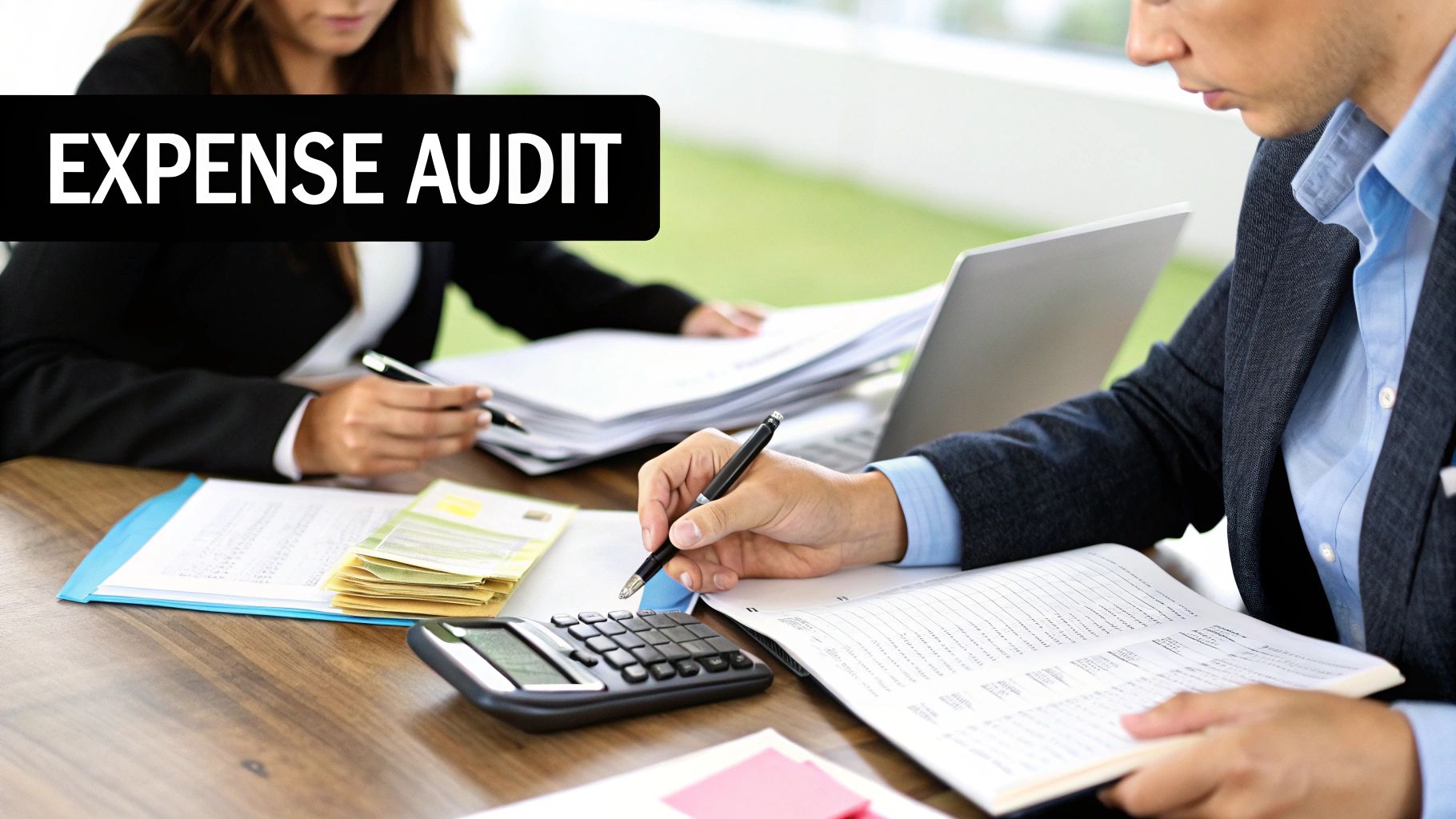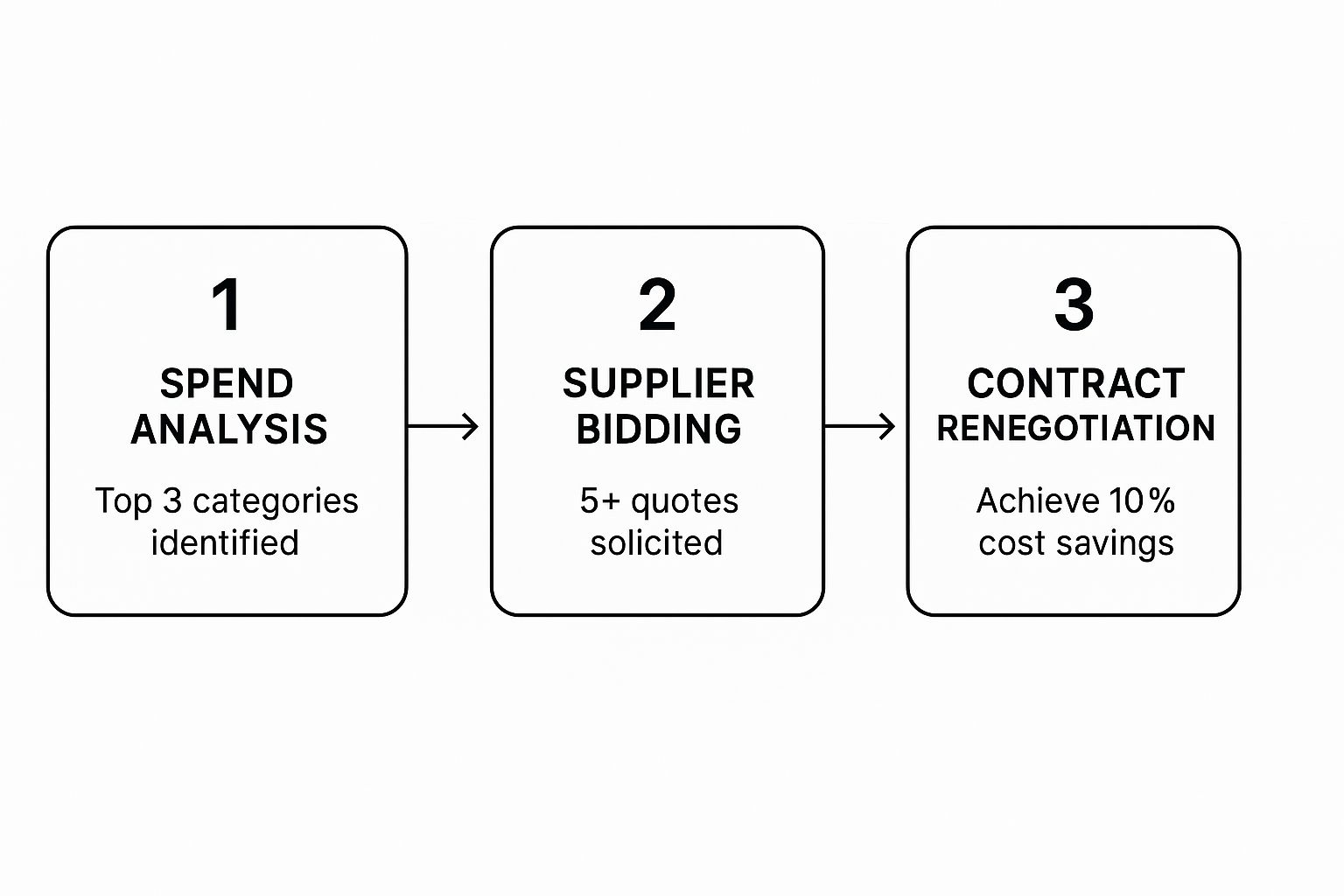
How to Reduce Operational Costs: Proven Strategies to Save Money
Share
Welcome. If you're here, you're looking for real, actionable ways to cut your operational costs. Forget the old slash-and-burn tactics that hamstring your team and stall growth. A single approach just doesn't cut it anymore. What works is a smarter, multi-pronged strategy that combines clever technology, the power of group purchasing, and fine-tuned financial processes.
A Modern Take on Slashing Business Expenses
 For years, "budget cuts" was a dirty phrase, often meaning you had to sacrifice quality or put growth on the back burner. That's not the case today. Learning how to genuinely reduce operational costs is about working smarter, not just cheaper. It’s about making strategic changes that eliminate waste while actually improving your team’s ability to perform.
For years, "budget cuts" was a dirty phrase, often meaning you had to sacrifice quality or put growth on the back burner. That's not the case today. Learning how to genuinely reduce operational costs is about working smarter, not just cheaper. It’s about making strategic changes that eliminate waste while actually improving your team’s ability to perform.
This guide is designed to move you beyond basic belt-tightening. We'll get into sustainable, intelligent cost management that can fuel your growth. For instance, shared purchasing platforms are a game-changer, giving smaller businesses access to top-tier tools without the hefty price tag. At the same time, simply refining your internal workflows can uncover hidden expenses and add real money back to your bottom line.
Core Strategies for Sustainable Savings
The real goal is to shift your mindset from reactive cost-cutting to proactive cost optimization. This means you need to look at your expenses differently—not just as line items on a spreadsheet, but as investments that must deliver a clear, measurable return. I've seen companies migrate from clunky, old IT systems to cloud-based solutions and free up 20-35% of their IT budgets almost overnight. That’s the kind of impact we’re talking about.
We're going to build this approach on three solid pillars:
- Group Purchasing Power: Using platforms like AccountShare to get high-cost software and services for a fraction of what you'd pay alone.
- Workflow Optimization: Automating tedious, repetitive tasks and cleaning up your internal processes to cut down on hidden labor costs and boost efficiency.
- A Modern Tech Stack: Switching to scalable cloud solutions and using smart tools to find financial leaks and make sure your resources are being used effectively.
The most significant cost reduction doesn't come from a single silver bullet. It's born from a holistic view—a mix of intelligent purchasing, better processes, and strategic technology choices.
By weaving these strategies together, you'll build a more resilient and financially lean organization. The next sections will give you the practical steps and real-world examples you need to put these ideas into action.
To help you visualize these concepts, here is a quick breakdown of the core strategies we will be discussing.
Core Strategies for Operational Cost Reduction
| Strategy | Primary Benefit | Key Focus Area |
|---|---|---|
| Group Purchasing | Access premium tools affordably | Shared software subscriptions, bulk service agreements |
| Process Optimization | Reduce wasted time and labor | Automation, workflow analysis, eliminating redundant tasks |
| Tech Stack Modernization | Lower IT overhead and improve data | Cloud migration, SaaS consolidation, AI-driven analytics |
This table provides a high-level overview, but the real value comes from digging into the details of how to implement each strategy within your own business. Let's get started.
Unlock Immediate Savings with Collective Purchasing

One of the fastest ways to slash your operational costs is to stop overpaying for the tools your business relies on. For years, small and medium-sized businesses have been at a disadvantage, priced out of the top-tier software that larger corporations use. Collective purchasing flips that script entirely.
Think about it: instead of your company shouldering a $500/month subscription fee for a premium tool, what if ten businesses shared that cost? Each would pay a small fraction of the price. This isn't just a theory; it's the practical model behind platforms like AccountShare, which facilitate this process in a way that’s secure, simple, and legitimate.
Suddenly, you have the buying power of a major enterprise, even if you’re a five-person startup. It’s a game-changer that makes the best tools accessible, turning what was once a major capital drain into a minor, predictable expense.
Zero In on the Right Tools for Your Team
First things first: you need to figure out which subscriptions are actually moving the needle and which are just quietly draining your bank account. I always recommend a quick audit of your monthly software spending—the results can be eye-opening. You'll likely discover you're paying for multiple tools with the same features or for licenses that team members haven't touched in months.
Once you have that clear picture, you can spot the high-cost, high-impact tools that are prime candidates for group buying. I’ve seen this work wonders for:
- Marketing and SEO Suites: These are crucial for getting seen, but their monthly fees can be staggering.
- Design and Creative Software: Essential for building a brand, yet individual licenses are notoriously expensive.
- AI and Productivity Tools: Powerful platforms that can give you an edge, but are often priced out of reach for small teams.
A marketing agency I know was able to consolidate their subscriptions for separate SEO, social media, and content tools. By joining a group purchase for an all-in-one platform, they cut their software budget by nearly 70%. You can dive deeper into different ways to boost your business with collective buying power to see what fits your situation.
How to Safely Join a Purchasing Group
The good news is you don’t have to do this on your own. Using a dedicated platform makes the whole process straightforward and secure. These services manage all the tricky parts, from collecting payments to distributing account access, all while keeping everyone’s information safe.
On a platform like AccountShare, the process is built for trust and transparency. You simply find the tool you need, join a pre-vetted group, and get access through a secure portal. The platform is the middleman, ensuring everyone plays by the rules and access is managed correctly. This completely sidesteps the risks and headaches of trying to organize a group buy yourself.
Key Takeaway: Collective purchasing isn't just a clever cost-cutting tactic. It's a strategic decision to equip your team with better resources. It levels the playing field and frees up cash you can reinvest in growth, talent, and innovation.
Ultimately, this approach gives you a direct answer to the question of how to reduce operational costs without compromising on quality. By fundamentally changing how you buy essential services, you can unlock immediate savings and give your team the best tools on the market.
Automating Workflows to Cut Hidden Labor Costs
Beyond smart purchasing, some of the biggest cost savings are hiding in plain sight: the "hidden" expenses of manual labor. Think about how much time your team sinks into repetitive, low-value work. Data entry, pulling reports, scheduling, processing invoices—every minute spent on these tasks is a minute not spent on growing the business.
Automating these workflows isn't just a nice-to-have for efficiency. It's a direct cost-reduction strategy. It helps you sidestep the human errors that lead to costly rework and wasted time. By putting these processes on autopilot, you build a more predictable operation and give your team back their most valuable asset: their time and brainpower for strategic thinking.
Finding Your Best Automation Opportunities
So, where do you start? The first step is to figure out where manual effort is costing you the most. A simple workflow audit can be eye-opening. Just ask your teams: "What daily or weekly tasks eat up the most time but require the least amount of creative thought?" Those are your low-hanging fruit for automation.
You'll often find prime candidates in a few key areas:
- Finance and Accounting: Automating invoice processing, expense approvals, and even payroll can shave off a massive number of administrative hours.
- Customer Service: Using chatbots for common first-contact questions or setting up automated ticketing systems can manage simple, high-volume requests. This frees up your human agents to handle the truly complex customer issues.
- Data Management: Think about the time spent manually moving data between your CRM and your email marketing tool. Automating that transfer prevents errors and saves an incredible amount of tedious work.
I once worked with a logistics company that was getting buried under the labor costs of manually keying in shipping details and scheduling deliveries. They brought in robotic process automation (RPA) and ended up automating over 80% of their data entry. The result? They cut scheduling errors in half and were able to move three full-time employees into higher-value customer relations roles.
This visual lays out a straightforward process for spotting and acting on these kinds of cost-saving opportunities through spend analysis and smart negotiation.

As you can see, a structured approach is what gets you from analysis to real savings. It’s this kind of focused effort that leads to measurable results, like a 10% cost reduction.
Choosing the Right Automation Tools
The tools you pick will really depend on the specific workflows you're targeting. You don't need to go out and buy a massive, complex system to get started. In my experience, the best place to begin is with the automation features already built into the software you currently use. Once you max those out, you can explore more dedicated platforms for advanced needs.
The concept isn't new. Adopting lean principles has long been a proven strategy. Research shows that companies implementing lean methods can cut production waste by 20% to 50%. When you pair those principles with modern tools like RPA, the impact is even greater. Businesses have seen labor costs drop by up to 30%, with some slashing overall operational expenses by as much as 40% in just a few years. You can discover more research about reducing operational costs to see the data for yourself.
Ultimately, automation is about building a more resilient, efficient, and cost-effective organization. By systematically getting rid of manual bottlenecks, you don’t just lower your expenses—you empower your team to focus on what they do best: driving your business forward.
Optimizing Your Technology And Infrastructure Spend
 Let's be honest, your tech stack and infrastructure are either a massive asset or a quiet money pit. Those clunky, on-premise systems aren't just slow; they're a constant drain on your budget, chewing up cash for maintenance, physical space, and manual oversight. Moving to modern, cloud-based solutions is one of the most powerful first steps you can take toward running a leaner, more agile business.
Let's be honest, your tech stack and infrastructure are either a massive asset or a quiet money pit. Those clunky, on-premise systems aren't just slow; they're a constant drain on your budget, chewing up cash for maintenance, physical space, and manual oversight. Moving to modern, cloud-based solutions is one of the most powerful first steps you can take toward running a leaner, more agile business.
Think about it: swapping capital-heavy legacy IT for flexible, scalable cloud services brings immediate savings. You stop paying for server hardware you might not even be using and instead adopt a pay-as-you-go model. This one change can free up a surprisingly large chunk of your budget—money you can pump back into growth instead of just keeping the lights on.
Plus, a modern tech stack gives you the clear data visibility you need to make smarter decisions. When everything is interconnected, you get a much sharper picture of your company's operational health, which helps you spot hidden inefficiencies you never knew existed.
Pinpoint Cost Leaks with Advanced Analytics
Once you've modernized your foundation, it's time to bring in the big guns to find and plug those financial leaks. I've seen AI-driven analytics platforms work wonders here. They can sift through enormous datasets to identify patterns and anomalies that a human team could easily miss, from underused software licenses to inefficient cloud resource allocation.
For example, an analytics tool might flag that your marketing team is consistently over-provisioning its cloud storage, leading to extra monthly fees you don't need to pay. A simple adjustment based on that real-world data means instant savings without hurting performance. These small, data-backed tweaks really add up over the year.
Key Insight: Real cost optimization isn't about blind budget cuts. It's about using data to make precise, intelligent decisions that eliminate waste while preserving—or even improving—your ability to operate effectively.
The data backs this up. Global surveys show that tech modernization is a cornerstone of cost management. Roughly 60% of executives are simplifying their organizational structures, reporting average savings of 15-25% on indirect costs. At the same time, swapping out legacy systems for cloud solutions has been shown to free up 20-35% of IT budgets and cut system downtime by a massive 30%. You can read more on these strategic cost reduction findings to see just how big the impact can be.
Restructure for Peak Efficiency
Of course, technology is only half the battle. Your company's internal structure can be a major source of high operational costs. Complicated hierarchies, overlapping roles, and siloed departments all create friction and bloat, which drives up indirect expenses like management overhead and administrative pay.
Streamlining your organizational chart can have a huge effect. By flattening hierarchies and clarifying who does what, you not only make communication faster but also trim a lot of fat from your payroll. Every redundant layer of management you remove is a direct saving. Our guide on the top ways to reduce software costs and boost IT efficiency dives deeper into how these structural and tech changes feed off each other.
This isn't about cutting jobs for the sake of it. It’s about making sure your team structure actually supports your business needs, ensuring every single role has a clear purpose and directly contributes to your goals. The result is a more focused, efficient, and cost-effective organization.
Using Remote Work and Outsourcing to Your Advantage
The way we work has changed for good, and smart businesses are using this shift to dramatically lower their operational costs. Tapping into remote or hybrid work and strategically outsourcing specific tasks aren't just passing fads. They represent a fundamental change in how to run a leaner, more efficient company.
The most direct win? A smaller office. Less physical space means a lower rent check, smaller utility bills, and fewer maintenance headaches. For any business in a major city, commercial rent is often a huge chunk of the monthly overhead. Cutting that expense frees up serious cash that can be put back into what really matters—growing your business.
Getting your team set up for this is easier than ever. With powerful cloud-based platforms like Microsoft Teams or Google Workspace, your team can collaborate just as effectively as they did in the office. This keeps everyone productive while also letting you ditch expensive, on-site IT hardware.
The Power of Smart Outsourcing
Beyond rethinking where your team works, there's another powerful way to trim the fat: strategic outsourcing. This isn't about just sending jobs elsewhere to save a buck. It’s about being smart and identifying the parts of your business that specialized experts can handle better and more affordably.
What should you look at outsourcing? Think about the tasks that are absolutely necessary but aren't part of your core business offering.
- Accounting and Bookkeeping: You need perfect books, but you don't need a full-time accountant on staff. A specialized firm can often do it better for less.
- IT Support & Cybersecurity: Instead of paying one senior IT manager's salary, a managed service provider (MSP) gives you a whole team of experts on call.
- Customer Service: For those initial customer questions, an outsourced team can offer 24/7 support without the massive cost of an in-house call center.
This move does more than just cut down on salaries, benefits, and training. It gives you immediate access to top-tier talent. It frees up your core team to laser-focus on the work that actually makes you money and builds your brand.
A Quick Framework for Outsourcing Decisions
Deciding what to hand off requires a bit of thought. Here's a simple way I've seen it work well: list all your business functions. Then, ask two questions for each one: how critical is this to our main product/service, and how good are we at it?
The sweet spot for outsourcing is any task that isn't central to your strategy but requires a high level of skill. You get incredible results without the cost and distraction of building that team yourself.
The numbers back this up completely. Recent studies show that businesses moving to a hybrid model shrink their office needs by 20-30%. That translates to saving between $10,000 and $15,000 per employee every year on rent alone. The shift to cloud tools has also been shown to cut IT spending by about 25%. On top of that, smart outsourcing can trim employee-related costs by another 10-20%.
When you combine a flexible work model with targeted outsourcing, you're not just cutting costs—you're redesigning your business to be more agile and financially sound. If you want to dig deeper, you can explore more cost reduction strategies for 2025 and see how all these pieces fit together.
Common Questions About Reducing Operational Costs
Even with a solid plan in place, trying to trim operational costs often brings up some tricky questions. It's one thing to have a strategy, but another to put it into practice. Let's walk through some of the most common concerns I hear from business owners and managers, so you can move forward with confidence.
Where Should I Start Looking for Savings First?
Your recurring expenses are the low-hanging fruit. I’m talking specifically about your software subscriptions and supplier contracts. It's where the quickest wins are usually found.
So many businesses fall victim to what’s known as “maverick spending”—those sneaky, unauthorized purchases that happen outside of approved contracts. This can cause some serious cost leakage over time.
Start by doing a full-blown audit of your monthly bills. Be ruthless. Are you paying for three different project management tools when one would do? Challenge any supplier contract that’s been sitting untouched for more than three years. You'd be surprised how often your pricing has become uncompetitive as market rates have shifted.
Is It Really Worth the Effort to Automate Small Tasks?
Without a doubt. Automating a single, small task might only shave a few minutes off someone's day, but when you multiply that across your entire team and over a full year, the impact is huge.
Think about all the little administrative jobs that eat up time: processing invoices, manual data entry, pulling the same weekly reports. These tasks quietly add up to hundreds of hours in labor costs. By getting these internal processes on autopilot, you’re not just cutting down on transactional costs—you’re freeing up your team to focus on work that actually grows the business.
For a deeper dive into this, check out our guide on 7 smart tips to reduce business costs.
How Can I Cut Costs Without Sacrificing Quality?
This is the big one, right? The key is to be strategic, not just a budget slasher. The goal isn't just to spend less; it's to get more value for every dollar you do spend. Collective purchasing is a perfect illustration of this principle in action.
By joining a group buy for a premium software tool, you're not settling for a cheap, inferior alternative. You’re getting access to the exact same high-quality tool as a massive enterprise, just at a fraction of the price. It’s the definition of spending smarter.
Outsourcing non-essential functions is another great example. Bringing in specialized firms for things like IT support or bookkeeping can often deliver better results for less money than hiring someone in-house. It lets your core team stick to what they do best while experts handle the rest. This is how you cut expenses without cutting corners.
Take the video company Kaltura, for instance. They switched from a standard SaaS logging solution to a more flexible cloud service. The result? They slashed their observability costs by a staggering 60%, while also improving their log retention and centralizing their whole platform. That’s a strategic move that boosts capability and drops operational expenses at the same time.
Ready to unlock enterprise-level tools without the enterprise-level price tag? AccountShare gives you the collective buying power to access premium software and services for a fraction of the cost. Stop overpaying and start saving today. Learn how AccountShare can reduce your operational costs.
